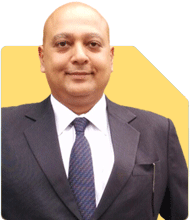Ramalingam Kalirajan |6272 Answers |Ask -Follow
Mutual Funds, Financial Planning Expert - Answered on Aug 16, 2024
He has an MBA in finance from the University of Madras and is a certified financial planner.
He is the director and chief financial planner at Holistic Investment, a Chennai-based firm that offers financial planning and wealth management advice.... more

My Friend have 2Crore Rs Fd he is 45 now with 2 kids and wife.He want to go for retirement (with no work).Is it ok for his entire life?
Evaluating the Current Financial Position
Fixed Deposit as the Main Asset
Safety and Security: A Fixed Deposit is a safe investment option. It guarantees returns and protects the principal amount. For someone looking for financial security, it’s a stable choice.
Returns: However, the returns from FDs are relatively low, usually around 5-6% per annum. Given the current inflation rate, which is often around 5-6% as well, the real returns might be negligible. This means the purchasing power of money might not grow substantially, which can be a concern over a long retirement period.
Taxation: The interest earned on FDs is taxable. This reduces the effective return, especially for someone in a higher tax bracket. It’s essential to account for this when planning for retirement.
Family Responsibilities
Children's Education: With two kids, there will be significant future expenses related to their education. Higher education costs are increasing rapidly, and your friend needs to ensure there’s enough provision for this.
Family's Lifestyle: Maintaining the family’s current lifestyle is also crucial. If your friend plans to retire early, the family will need enough income to cover daily expenses, healthcare, and other unforeseen costs for the next few decades.
Healthcare Costs
Medical Emergencies: Healthcare costs tend to rise as one ages. Your friend will need to ensure he has sufficient health insurance coverage. Additionally, some funds should be allocated for unexpected medical expenses that may not be covered by insurance.
Longevity Risk
Living Longer: One of the most critical factors to consider is longevity. With advancements in healthcare, people are living longer. Your friend could potentially live for another 30-40 years. The Rs 2 crore in FD needs to last for this entire period.
Assessing the Sufficiency of Rs 2 Crore
Income Generation from FD
Interest Income: If we assume an interest rate of 6% on Rs 2 crore, the annual income from the FD would be around Rs 12 lakh before tax. After accounting for taxes, the net income might reduce to Rs 9 lakh or less, depending on the tax bracket.
Monthly Income: This translates to roughly Rs 75,000 per month. The big question is whether this amount is sufficient to cover all expenses, including living costs, children's education, healthcare, and other needs.
Inflation Impact
Eroding Value: Inflation will continue to erode the value of money over time. What costs Rs 1 lakh today might cost Rs 2 lakh or more in the future. If the income from FD does not grow in line with inflation, your friend might struggle to maintain the same lifestyle in the coming years.
Unforeseen Expenses
Unexpected Costs: Life is unpredictable. There could be unexpected expenses like home repairs, healthcare emergencies, or even financial support for children well into their adulthood. These costs can quickly deplete the FD savings.
Exploring Alternative Strategies
Diversifying Investments
Actively Managed Mutual Funds: Relying solely on Fixed Deposits may not be the best strategy for long-term financial security. Your friend should consider diversifying his investments into actively managed mutual funds. These funds are managed by professionals who aim to outperform the market. They offer the potential for higher returns, which could help in combating inflation and growing the retirement corpus over time.
Debt Funds: For a safer option, debt funds can be considered. They invest in fixed-income instruments like government bonds, corporate bonds, and other debt securities. While they carry some risk, they typically offer better returns than FDs and are more tax-efficient.
Systematic Withdrawal Plans (SWP): Post-retirement, your friend can consider setting up a Systematic Withdrawal Plan from mutual funds. This allows him to withdraw a fixed amount regularly while the remaining corpus continues to grow. It can act as a steady income stream, similar to a pension.
Insurance and Risk Management
Life Insurance: If your friend has investment-cum-insurance policies like ULIPs, he should consider surrendering them. These policies often have high costs and offer lower returns. Instead, he can reinvest the surrender value into mutual funds and purchase pure term insurance for adequate life coverage.
Health Insurance: A robust health insurance plan is essential. As he ages, medical expenses are likely to increase. Comprehensive health coverage ensures that these costs do not eat into the retirement savings.
Estate Planning
Will and Trust: It's crucial to have a proper estate plan in place. Drafting a will ensures that your friend's assets are distributed according to his wishes. If the assets are significant, he might also consider setting up a trust. This helps in efficient wealth transfer and provides financial security for his wife and children.
Nomination: Ensure that all investments and insurance policies have proper nominations. This simplifies the process for the family in case of any unforeseen events.
Regular Review and Adjustment
Annual Review: Your friend should review his financial plan annually with a Certified Financial Planner. This helps in assessing the performance of investments and making necessary adjustments based on changing circumstances and goals.
Rebalancing the Portfolio: Over time, as your friend gets older, the investment portfolio should gradually shift towards safer assets. This reduces risk and protects the accumulated wealth, ensuring it lasts throughout retirement.
Tax Efficiency
Tax Planning: Effective tax planning is crucial to maximise the income from investments. Your friend should explore tax-saving options under Section 80C and other applicable sections to reduce taxable income. Investments in tax-efficient instruments, such as Equity-Linked Savings Schemes (ELSS), can provide the dual benefit of tax savings and potential growth.
Finally
Retiring at 45 with Rs 2 crore in FD is a significant decision. While it provides safety, it may not be sufficient for a lifetime without a strategic financial plan. Your friend should consider diversifying his investments, planning for inflation, ensuring adequate insurance, and regularly reviewing his financial plan. This approach will help him achieve a secure and comfortable retirement, ensuring that his wealth lasts for the entire family’s needs.
Best Regards,
K. Ramalingam, MBA, CFP
Chief Financial Planner,
www.holisticinvestment.in
You may like to see similar questions and answers below
Hardik Parikh |106 Answers |Ask -Follow
Tax, Mutual Fund Expert - Answered on May 04, 2023
Ramalingam Kalirajan |6272 Answers |Ask -Follow
Mutual Funds, Financial Planning Expert - Answered on May 07, 2024
Ramalingam Kalirajan |6272 Answers |Ask -Follow
Mutual Funds, Financial Planning Expert - Answered on Jul 30, 2024
Ramalingam Kalirajan |6272 Answers |Ask -Follow
Mutual Funds, Financial Planning Expert - Answered on Jun 20, 2024
Ramalingam Kalirajan |6272 Answers |Ask -Follow
Mutual Funds, Financial Planning Expert - Answered on Aug 29, 2024
Sushil Sukhwani |543 Answers |Ask -Follow
Study Abroad Expert - Answered on Sep 11, 2024
Dr Dipankar Dutta |581 Answers |Ask -Follow
Tech Careers and Skill Development Expert - Answered on Sep 11, 2024
Dr Dipankar Dutta |581 Answers |Ask -Follow
Tech Careers and Skill Development Expert - Answered on Sep 11, 2024
Ramalingam Kalirajan |6272 Answers |Ask -Follow
Mutual Funds, Financial Planning Expert - Answered on Sep 11, 2024
Radheshyam Zanwar |839 Answers |Ask -Follow
MHT-CET, IIT-JEE, NEET-UG Expert - Answered on Sep 11, 2024
Radheshyam Zanwar |839 Answers |Ask -Follow
MHT-CET, IIT-JEE, NEET-UG Expert - Answered on Sep 11, 2024
Ramalingam Kalirajan |6272 Answers |Ask -Follow
Mutual Funds, Financial Planning Expert - Answered on Sep 11, 2024
Sushil Sukhwani |543 Answers |Ask -Follow
Study Abroad Expert - Answered on Sep 11, 2024
Dr Nagarajan J S K |115 Answers |Ask -Follow
Health Science and Pharmaceutical Careers Expert - Answered on Sep 11, 2024
Anu Krishna |1155 Answers |Ask -Follow
Relationships Expert, Mind Coach - Answered on Sep 11, 2024

























